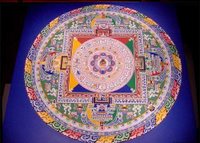An addendum to my previous post: you can find out more about the whole 'Gospel of Judas' saga by going here:
http://www9.nationalgeographic.com/lostgospel/But I have to vent. Their
timeline page is terribly misleading. See, if you mouse over the timeline, by the order of the dots, it implies that Jesus died, then the gospels were written, and then Paul spread Christianity.
Argh. That's not what scholars believe to be true at all!
And if you look at the dates they specify, you can see that reflected.
Jesus died c. 30 AD
Gospels were written 65-95 AD (I have a bit of a problem with these dates, but let's go with them for a moment)
St. Paul expands the faith c. 68 AD (Again, some problems with this date)
Now, why would you list those things 1, 2, 3, when clearly, 68 AD comes before 90 AD?
The gospels were
not (I emphasize *NOT*) written before Paul. No way. First of all, Paul's letters are typically dated 50-60 AD, not 68 AD. The Gospel of Mark is the earliest canonical gospel, and it's earliest date is 65 AD, though many scholars believe it was written in the 70s. And then there's Matthew and Luke, which were written at the *earliest* in 80 AD (scholars date them between 80-100 and 80-130, respectively). And finally, we get John, which was written at the *earliest* in 90 AD, and could have been as late as 120!
So... let's recap. The order according to National Geographic is Jesus, Gospels, Paul. The order according to scholars is Jesus, Paul, Gospels. And don't think it doesn't make a difference, because it makes all the difference in the world that our "eye-witness accounts" were written anywhere from 35 - 100
years after the death of Jesus. They weren't all written 35 years after Jesus' death, no matter what National Geographic implies. And yes, I realize that their timeline does say that the gospels were written
between 65 - 95. But then why did they put a single dot for the time of the writing of the gospels (before Paul), rather than show the span of time? It's sloppy, and it implies a school of thought that scholars have been trying to overcome for years now. The gospels are not earlier than Paul, they are later.
Grumble, grumble, grumble.
In all fairness to the good folks at National Geographic, at least they got the order in the
text-only version right.
And finally, for more on other Gospels and early Christian writings which didn't make the New Testament, check out
Early Christian Writings, where you can read tonnes of stuff from the first three centuries of the Common Era.
 A very important concept in Buddhism is that of impermanence, being one of the Three Marks of Existence (for more information, check out the link). Impermanence is more than just a nice concept, though, as evidenced by the practice of creating Sand Mandalas. The mandalas themselves are absolutely incredible... check out some of the pictures for yourself. Go through all of the pages to see the construction from beginning to end, and the subsequent reminder of impermanence. The BBC has more information on the importance of the mandala's ritual creation and destruction.
A very important concept in Buddhism is that of impermanence, being one of the Three Marks of Existence (for more information, check out the link). Impermanence is more than just a nice concept, though, as evidenced by the practice of creating Sand Mandalas. The mandalas themselves are absolutely incredible... check out some of the pictures for yourself. Go through all of the pages to see the construction from beginning to end, and the subsequent reminder of impermanence. The BBC has more information on the importance of the mandala's ritual creation and destruction.

